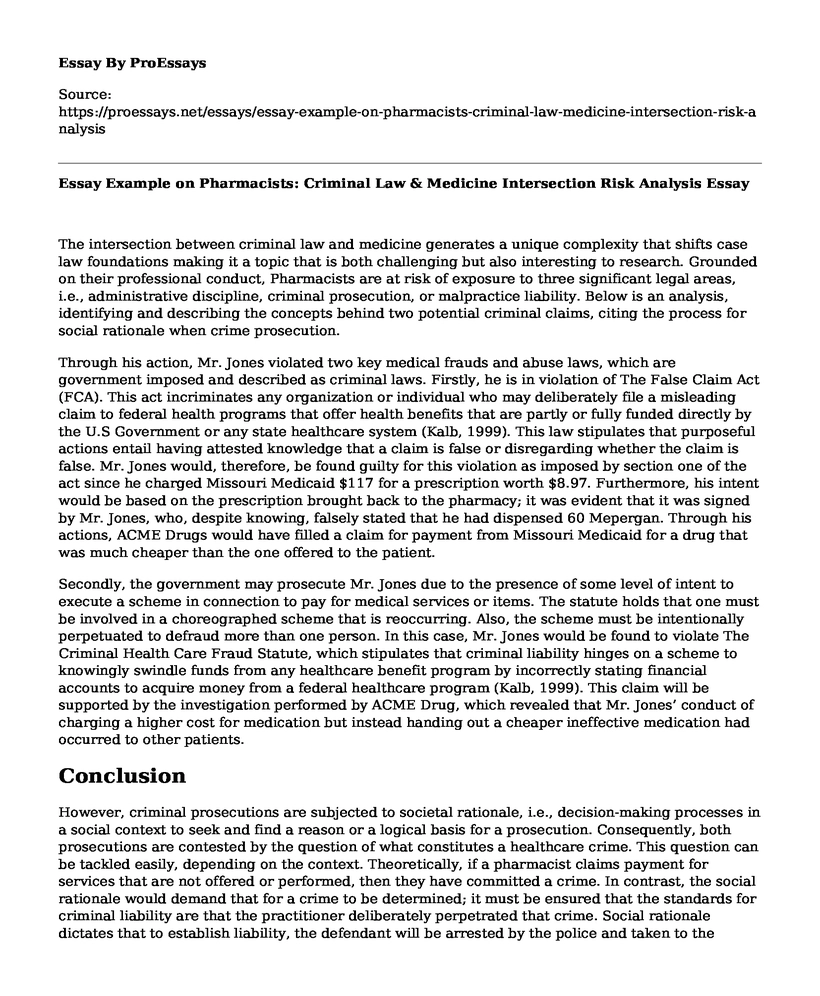The intersection between criminal law and medicine generates a unique complexity that shifts case law foundations making it a topic that is both challenging but also interesting to research. Grounded on their professional conduct, Pharmacists are at risk of exposure to three significant legal areas, i.e., administrative discipline, criminal prosecution, or malpractice liability. Below is an analysis, identifying and describing the concepts behind two potential criminal claims, citing the process for social rationale when crime prosecution.
Through his action, Mr. Jones violated two key medical frauds and abuse laws, which are government imposed and described as criminal laws. Firstly, he is in violation of The False Claim Act (FCA). This act incriminates any organization or individual who may deliberately file a misleading claim to federal health programs that offer health benefits that are partly or fully funded directly by the U.S Government or any state healthcare system (Kalb, 1999). This law stipulates that purposeful actions entail having attested knowledge that a claim is false or disregarding whether the claim is false. Mr. Jones would, therefore, be found guilty for this violation as imposed by section one of the act since he charged Missouri Medicaid $117 for a prescription worth $8.97. Furthermore, his intent would be based on the prescription brought back to the pharmacy; it was evident that it was signed by Mr. Jones, who, despite knowing, falsely stated that he had dispensed 60 Mepergan. Through his actions, ACME Drugs would have filled a claim for payment from Missouri Medicaid for a drug that was much cheaper than the one offered to the patient.
Secondly, the government may prosecute Mr. Jones due to the presence of some level of intent to execute a scheme in connection to pay for medical services or items. The statute holds that one must be involved in a choreographed scheme that is reoccurring. Also, the scheme must be intentionally perpetuated to defraud more than one person. In this case, Mr. Jones would be found to violate The Criminal Health Care Fraud Statute, which stipulates that criminal liability hinges on a scheme to knowingly swindle funds from any healthcare benefit program by incorrectly stating financial accounts to acquire money from a federal healthcare program (Kalb, 1999). This claim will be supported by the investigation performed by ACME Drug, which revealed that Mr. Jones’ conduct of charging a higher cost for medication but instead handing out a cheaper ineffective medication had occurred to other patients.
Conclusion
However, criminal prosecutions are subjected to societal rationale, i.e., decision-making processes in a social context to seek and find a reason or a logical basis for a prosecution. Consequently, both prosecutions are contested by the question of what constitutes a healthcare crime. This question can be tackled easily, depending on the context. Theoretically, if a pharmacist claims payment for services that are not offered or performed, then they have committed a crime. In contrast, the social rationale would demand that for a crime to be determined; it must be ensured that the standards for criminal liability are that the practitioner deliberately perpetrated that crime. Social rationale dictates that to establish liability, the defendant will be arrested by the police and taken to the Centers for Medicare & Medicaid Services. A prosecuting attorney is selected to represent the state and establish and prove the criminal salute, and a defense attorney to represent the defendant. The defendant will then be arraigned in court to present the accusatory instruments and set bail formally. A criminal proceeding commences with an indictment (Dressler et al. 1991). This way, both the prosecution and defense present their cases and arguments to a grand jury and a judge.
References
Dressler, J., Michaels, A. C., & Simmons, R. (1991). Understanding criminal procedure (p. 45). M. Bender. https://store.lexisnexis.com/__data/assets/pdf_file/0003/97032/DresslerUndCrimProVol1-and-22019SuppWM.pdf
Kalb, P. E. (1999). Health care fraud and abuse. JAMA, 282(12), 1163-1168. https://jamanetwork.com/journals/jama/article-abstract/191726
Cite this page
Essay Example on Pharmacists: Criminal Law & Medicine Intersection Risk Analysis. (2023, Aug 08). Retrieved from https://proessays.net/essays/essay-example-on-pharmacists-criminal-law-medicine-intersection-risk-analysis
If you are the original author of this essay and no longer wish to have it published on the ProEssays website, please click below to request its removal:
- Paper Example on Merck Company and River Blindness
- Evidence-Based Practice: Disseminating Genuine Results - Essay Sample
- Stephen's Sex Discrimination Case - Case Study
- Essay Example on Sampling Theory & Generalizability in Nursing Research
- Essay Example on Abortion Debate: Pro-Choice and Pro-Life Views in 2021
- Botswana's HIV Crisis - Free Essay Sample
- Free Paper Sample on Caries Risk and Primary Dentition in Children







